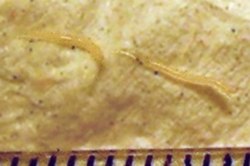Human pathogen
The human physiological defense against common pathogens (such as Pneumocystis) is mainly the responsibility of the immune system with help by some of the body's normal microbiota.
Some pathogens (such as the bacterium Yersinia pestis, which may have caused the Black Plague, the Variola virus, and the malaria protozoa) have been responsible for massive numbers of casualties and have had numerous effects on affected groups.
Pathogenic viruses are mainly those of the families of: Adenoviridae, Picornaviridae, Herpesviridae, Hepadnaviridae, Coronaviridae, Flaviviridae, Retroviridae, Orthomyxoviridae, Paramyxoviridae, Papovaviridae, Polyomavirus, Poxviridae, Rhabdoviridae, and Togaviridae.
Some notable pathogenic viruses cause smallpox, influenza, mumps, measles, chickenpox, ebola, and rubella.
White blood cells surround and consume the virus using a mechanism known as phagocytosis[2] (a type of endocytosis)[3] within the extracellular matrix to reduce and fight the infection.
Pathogenic bacteria also cause infections such as tetanus, typhoid fever, diphtheria, syphilis, and Hansen's disease.
[citation needed] Fungi are a eukaryotic kingdom of microbes that are usually saprophytes, but can cause diseases in humans.
Most antibiotics that function on bacterial pathogens cannot be used to treat fungal infections because fungi and their hosts both have eukaryotic cells.
Many protozoan pathogens are considered human parasites as they cause a variety of diseases such as: malaria, amoebiasis, babesiosis, giardiasis, toxoplasmosis, cryptosporidiosis, trichomoniasis, Chagas disease, leishmaniasis, African trypanosomiasis (sleeping sickness), Acanthamoeba keratitis, and primary amoebic meningoencephalitis (naegleriasis).
These abnormally folded proteins are found characteristically in many neurodegenerative diseases as they aggregate the central nervous system and create plaques that damages the tissue structure.


